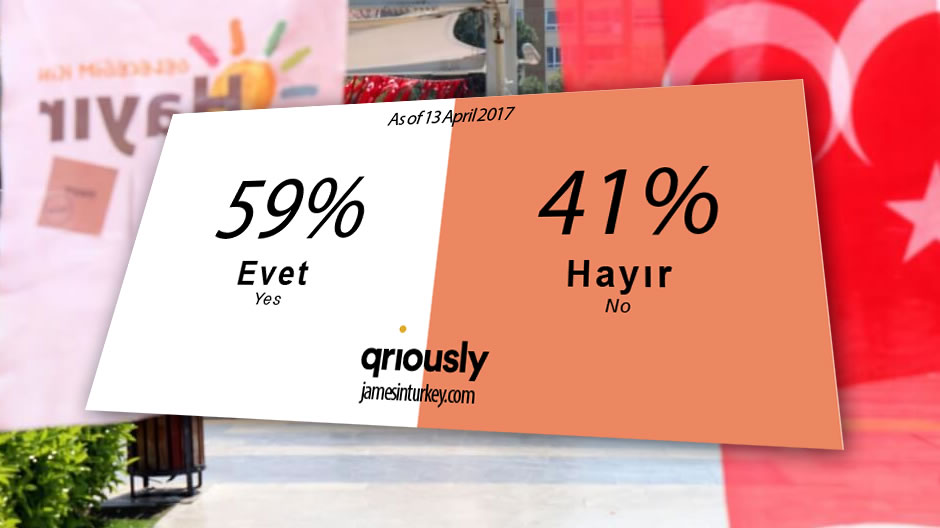The last Qriously poll published on JamesInTurkey.com retains a solid Yes lead, but the regional breakdown could generate surprises on Sunday
Followers of the last two waves will not be surprised that Qriously again predicts a strong Yes result (which changes from last week): YES 44.1 (+0.6) NO 30.6 (-0.5) UNDECIDED 25.3 (-0.1). This translates into an expressed vote of YES 59.0 NO 41.0.
The high number of undecided respondents remains troubling. Qriously maintains that, in its past experience, undecided voters “tend to split roughly in the same proportion as the rest of the electorate”. But all the provisos listed in earlier posts still apply.
The headline result aside, there are some interesting geographical trends to report on.
The big city
The mantra of any Turkish election is to watch its largest city. Istanbul tends to vote as the country votes, so in a contest with a binary choice like this one it will be all the more significant to watch on Sunday night.
For the second week running, Qriously has found a narrow but definite lead for the No camp in Istanbul: YES 46.9 NO 53.1.
That’s a 12.9 percentage point shift from three weeks ago, when the city was solidly voting Yes.
It is significant that Qriously has found a No lead for the second week in row because Istanbul’s electorate is well over 10 million – a fifth of the whole country – and turnout was 88% at the last general election. A high turnout here could swing the result.
Perplexing southeast
Unlike Istanbul, there has been no change in the southeast. It appears to be voting a solid Yes – around the 71 percent mark – despite being home to Kurdish voters in large numbers.
Qriously also asked respondents what party they would support in a hypothetical parliamentary election and just 5% said they would vote for the pro-Kurdish HDP.
This tallies with other pollsters that have found a significant drop in the party’s level of support and would suggest – but only suggest, mind – that Kurdish voters will be voting Yes or not at all.
Urban No, rural Yes
The darkest green regions of the map correspond roughly to Turkey’s least urbanised, least populated regions.
There are exceptions like Konya, Gaziantep and Erzurum are solid Yes regions – but these are strongly associated with the governing AK Party, so it is unsurprising that they are above 80 percent.
Inner parts of western Anatolia like Manisa and Afyon and the Mediterranean coast have weaker Yes leads: it is no coincidence that these are where the Nationalist Movement Party (MHP) is electorally more competitive. Its voters are split on whether to back their party’s leadership.
The west and northwest, traditionally associated with the main opposition Republican People’s Party (CHP), are unsurprisingly strong with the No side.
Results tables
Some have asked to see the full results tables published by Qriously. You can download them by clicking here.











